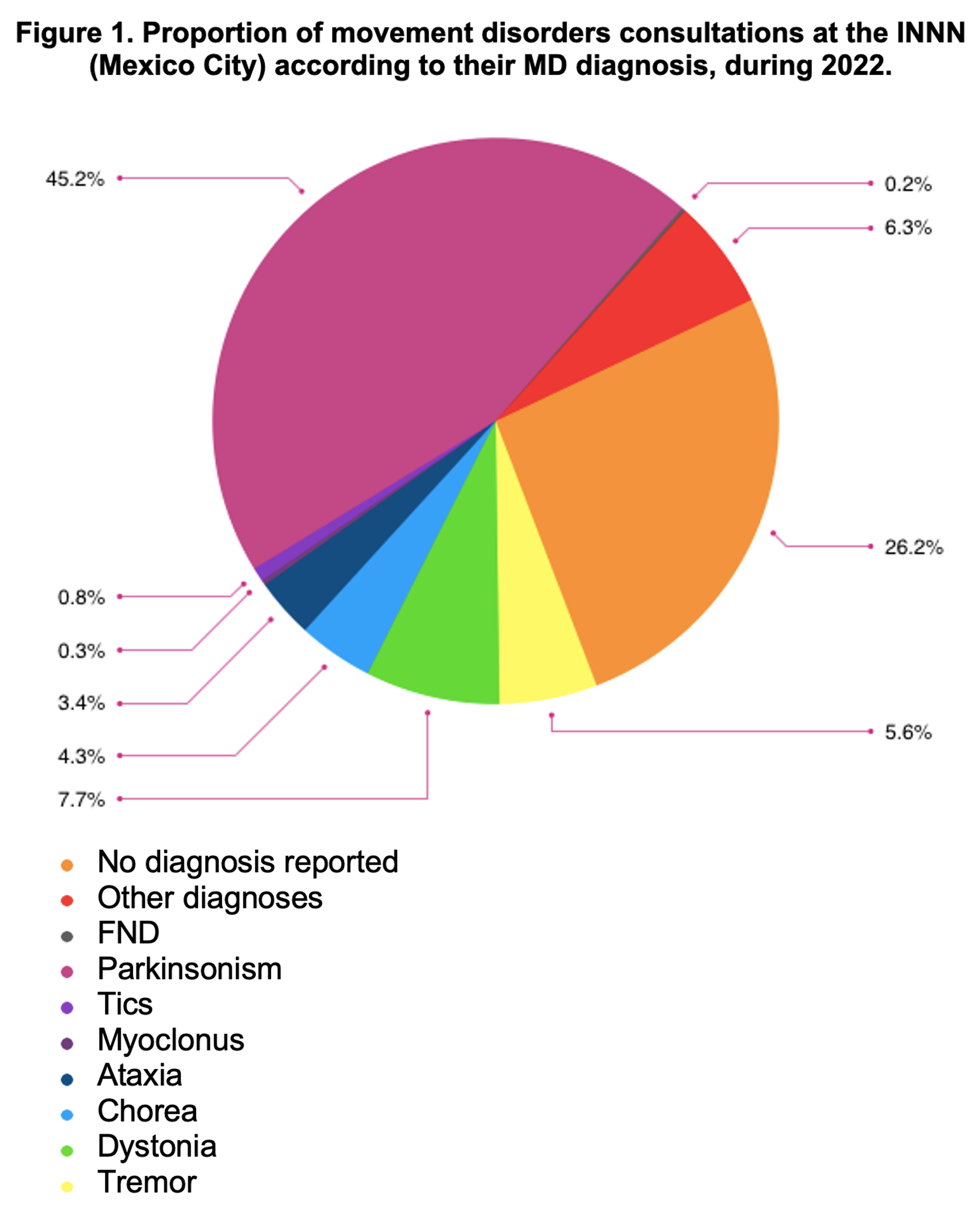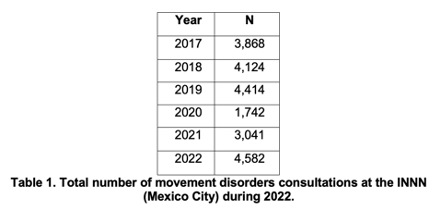Category: Epidemiology
Objective: To provide data about the movement disorders (MD) outpatient consultation (OC) service from the INNN, Mexico City during 2022.
Background: The INNN, inaugurated in 1964, is a reference center that allows specialized care for people with diseases of the nervous system, which also allows the training of human resources and the creation of new scientific knowledge on advances in neurosciences. According to open data from the Government of Mexico, the INNN grants >90,000 consultations and performs >2,000 surgical procedures a year; providing care to people with CVA, tumors, epilepsy, neurodegenerative diseases, among others (last updated 2017).
While persons with MD were regularly seen at the INNN, the MD-OC was not formally created until 1999. Currently, the Institute has 3 MD specialists, all trained abroad. Before the COVID-19 pandemic, an average of 3,500 consultations for persons with MD per year were given. Mexico lacks recent epidemiological data about epidemiology of MD. An update on number of consultations and frequency of the most common MD seen at the MD-OC is needed.
Method: An observational, retrospective study was carried out. The MD-OC from the institutional registry was evaluated. Variables included were age, gender, socioeconomic level (L0 to L6), and MD diagnosis.
Results: A total of 4,582 medical appointments (49.2% males, 58.3±16.2 years old) were given at the MD-OC (rate of assistance 84%), corresponding to 1,746 patients (52.9% females) attended during 2022. An increase of 150.7% was seen in the number of consultations when compared to past years [table 1]. MD were classified as hyper/hypokinetic disorders (22.7% vs. 45.4%), as well as according to their phenomenology (tremor 5.6%, dystonia 7.7%, chorea 4.3%, ataxia 3.4%, myoclonus 0.3%, tics 0.8%, parkinsonism 45.3%, functional neurological disorders (NFD) 0.2%, and others 6.3%) [figure1]. 26.3% of the consultations showed no diagnosis. The most frequent diseases (n=1746) were PD 33.9%, ataxia 4.8%, dystonia 3.9%, essential tremor (ET) 3.5%, atypical parkinsonism (AP) 3.4%, and HD 2.9%.
Conclusion: In the post-pandemic era, the MD-OC raised 1.5 times when comparing 2021 and 2022. PD is still the most common movement disorder among Mexican patients, followed by ataxia, dystonia, ET, AP, and HD. A follow-up on these patients is required for determining prevalence and incidence of MD in Mexico.
To cite this abstract in AMA style:
D P. Romero Teran, A J. Hernández Medrano, D R. Aguila Godinez, A A. Herrera Ruiz, E C. Santiago Cruz, M. Medrano Delgado, M A. Ruiz Mafud, A Y. Regalado Mustafá, M F. Medina Perez, G I. Cerda Hernández, M. Rodriguez Violante, A. Cervantes Arriaga, G. Hernandez Armesto, A. Abundes Corona, A. Dominguez Garcia, K. Talavera Lagunas. Movement disorders at the National Institute of Neurology and Neurosurgery (INNN, Mexico City): most common diagnoses during 2022. [abstract]. Mov Disord. 2023; 38 (suppl 1). https://www.mdsabstracts.org/abstract/movement-disorders-at-the-national-institute-of-neurology-and-neurosurgery-innn-mexico-city-most-common-diagnoses-during-2022/. Accessed October 17, 2025.« Back to 2023 International Congress
MDS Abstracts - https://www.mdsabstracts.org/abstract/movement-disorders-at-the-national-institute-of-neurology-and-neurosurgery-innn-mexico-city-most-common-diagnoses-during-2022/


